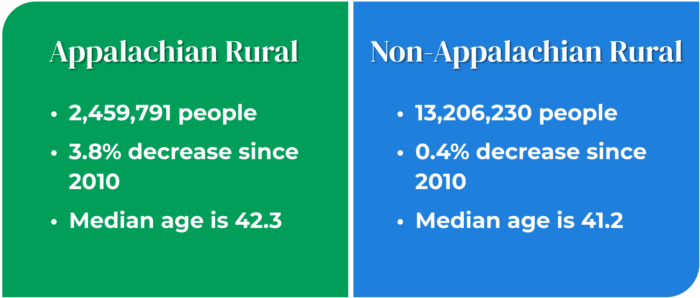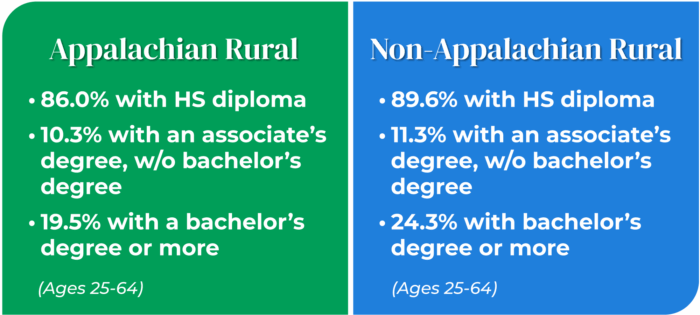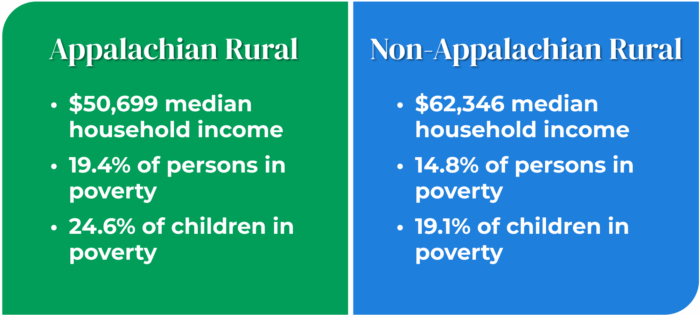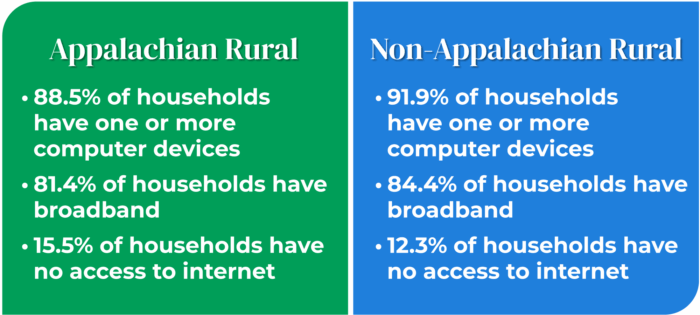Of the Appalachian Region’s 423 counties, 107, or one-fourth, are classified as rural—counties that are neither part of nor adjacent to a metropolitan area. Of the 26.6 million people that live in Appalachia, almost 2.5 million, or nearly 10% of residents, live in rural counties. How does the Appalachian rural experience compare to the 841 other similarly designated rural counties in the U.S.? Data show that Appalachia’s rural counties lagged behind these areas on most indicators, with residents finding themselves in more vulnerable economic positions pre-COVID-19.
Explore top takeaways below and this table of data point comparisons.
Rural County Designations
Rural counties are found in each of the 13 states in the Appalachian Region except Maryland and South Carolina. However, there are higher concentrations of rural counties in several states including Kentucky, Mississippi, Pennsylvania, Virginia and West Virginia.
Rural-Urban County Types in Appalachia

Rural Counties in the U.S.
The Appalachian Region consists of 206,000 square miles across 13 states, and both rural and major metropolitan areas. A comparison of Appalachia’s rural counties with other rural counties shows the region’s rural population is older and has been declining faster since 2010 than the population in rural counties in the rest of the country.
Rural County Comparisons
Population
Appalachia trends older, with a slightly higher median age and a lower percentage of the population under age 18. The region’s population has also been declining faster since 2010.

Education
Within the region, the high school completion prevalence among adults ages 25 and over increased the most in Central Appalachia and in Appalachia’s most rural counties. With these improvements, the share of adults completing high school as of 2019-2023 has reached 82.9% in Central Appalachia and 84.2% in the region’s rural areas. Working-age adults in rural Appalachia continue to lag behind those in non-Appalachian rural counties on all levels of education.

employment
The percentage of rural Appalachian adults ages 25 to 64 in the civilian labor force is about 8.4 percentage points lower than in rural counties outside the Region.
The unemployment rate in rural Appalachia is also slightly higher than rural non-Appalachian regions, at 4.8% versus 3.8%.
Income and Poverty
Median household income in rural Appalachian counties is more than $10,000 below that of households in rural counties in the rest of the country. A greater share of rural Appalachian residents live in poverty, with the gap being even wider among children (almost six percentage points). The lower levels of education and employment among adults in rural Appalachia are reflected in lower levels of income and higher rates of poverty than in rural counties outside the region.

Computer Device and Broadband Access



